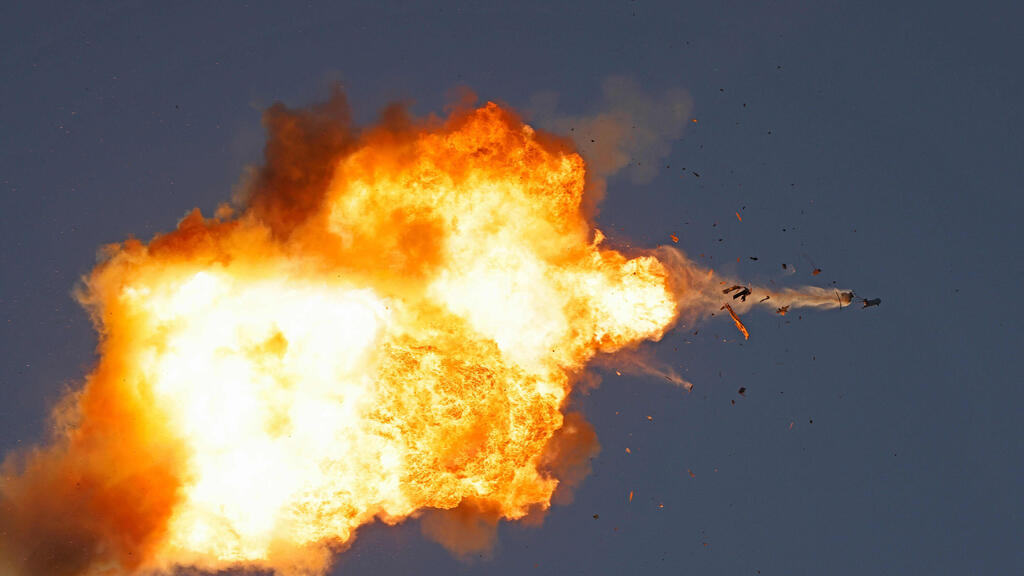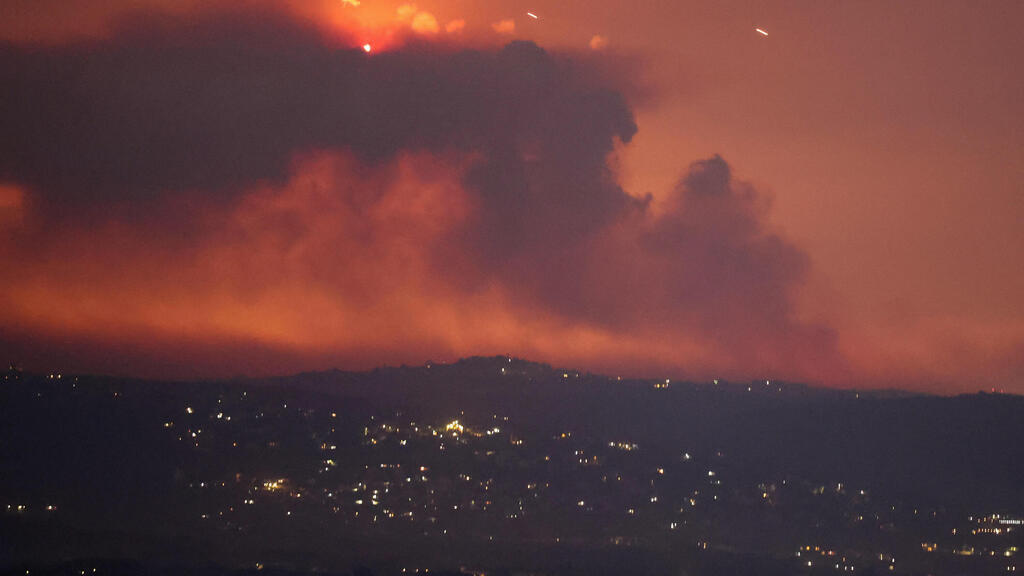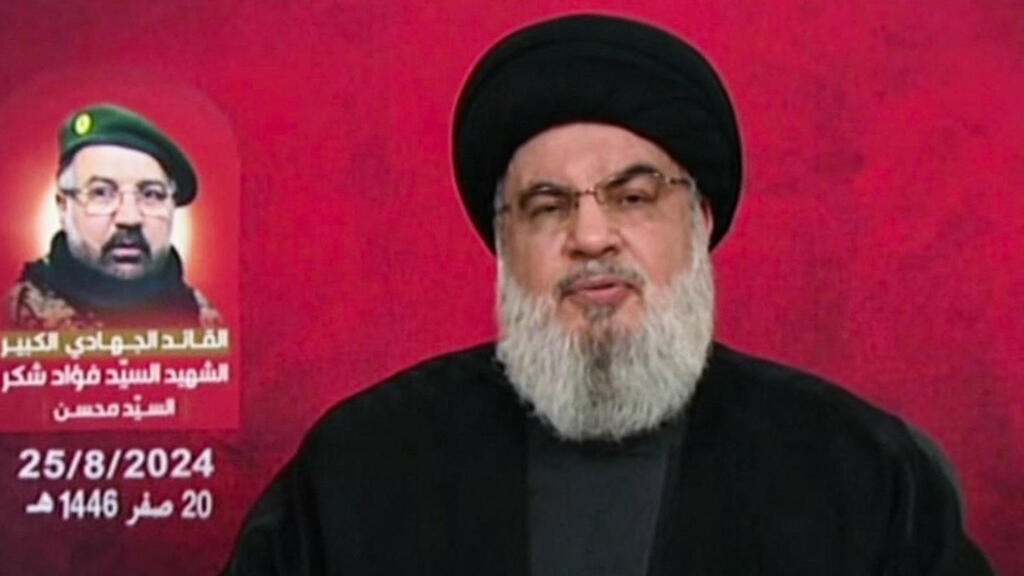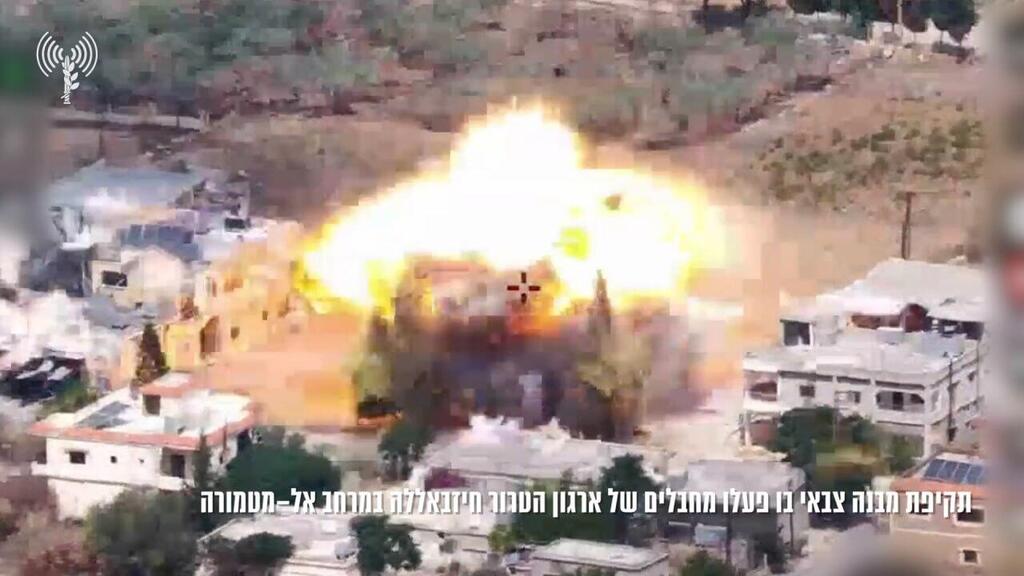Getting your Trinity Audio player ready...
IDF intelligence and senior defense officials were familiar with the proposal and knew long enough in advance about Hezbollah’s planned revenge strike in retaliation for the assassination of Fuad Shukr in Beirut: “The “Day of Arba'in,” when Shiites mourn the death of the third imam, Husayn Ibn Ali at the Battle of Karbala over 1,300 years ago.
It's reasonable to assume that Nasrallah chose this day, that fell of August 25, to use historical-religious aspects to stress the importance of Shukr, Hezbollah’s highest military authority, and Nasrallah’s friend and most important advisor. Hezbollah had to exact deterrence from Israel and signal to us that - be it targeted assassinations of senior Hezbollah operatives or attacks “to push Lebanon back to the Stone Age” as Gallant has been threatening for years – from now on, every Israeli attack on Beirut will be met with firing on Tel Aviv.
That said, the proposed operation was clear, and Nasrallah and his Iranian patrons are keen to avoid a major escalation. They seem to have, rightly, estimated that if the strike were to cause significant losses and destruction, including on the Israeli home front, the IDF would respond with force. In this case, the chances of Iran and its proxies needing to come to Hezbollah’s rescue would be high. It would result in a regional war that Iran really doesn’t want at this time.
4 View gallery


IDF intercepts a Hezbollah rocket during a major strike on the north in August
(Photo: Jalaa Marey / AFP)
The ayatollahs in Tehran know full well what would happen to their economy, nuclear facilities and their regime’s stability if such a war were to break out. They can see the deployment map of American air and naval forces and of their allies in the region. In April, they also saw what happened to their rockets and explosive UAVs as a result of IDF-CENTCOM (United States Central Command) cooperation, and were later treated to a sample of Israel’s long-range offensive capabilities.
So, as long as the US is present in such force in the region, and as long as Iran doesn’t have operational nuclear weapons, Tehran won’t let Hezbollah or any other element drag her into a regional war. This is also why after intensive debates Iran, refrained from launching a joint, or even coordinated, strike with Hezbollah.
The information regarded Hezbollah’s planned response, that turned ever-more detailed and credible, allowed the IDF to prepare not only for defense activities but also for several offensive operational plans of two kinds. The first type is an assassination campaign and the disruption of Hezbollah’s revenge attack before, or as, it, happens – professionally known as “preventative” or “preemptive” attacks (conducted when the enemy has completed its preparations and is about to attack).
The second kind of response is the Israeli response and retaliatory attacks during, or following Hezbollah’s attack. It was clear to defense and political establishment decision-makers from the outset that Israel wouldn’t wait for Hezbollah operatives to launch revenge barrages. Israel would rather utilize its quality intelligence to deliver a preemptive strike and disrupt Hezbollah’s plans, avert losses and destruction in the northern communities, and not allow important targets in Tel Aviv and the central part of the country to be hit.
A campaign if launched would not just reduce the Hezbollah threat to Israel’s home front for years to come and strip Iran of its most effective long-arm
A response, if required, will be decided in the future according to circumstances. The quality intelligence, however, presented decision-makers with the temptation of taking strategic steps that would bring about fundamental changes in the security situation on the country’s northern front.
Much of the top brass maintained (and still believe) that the “Day of Arba'in Operation” constituted a golden opportunity to give Hezbollah a strategic “ippon” (a fast, decisive restraining Karate or Judo move). It’s impossible to detail the operation proposed by these senior officials as the IDF may need to implement it in the future.
One my only imagine a scenario in which following, or even during, Hezbollah’s revenge attack, the IDF launches air, sea and ground attacks on all Hezbollah infrastructure across Lebanon. At the same time, we’ll conduct ground operations into South Lebanon that the long-suffering northern residents have demanded from the government and the IDF, and that the Northern Command is just waiting to implement.
4 View gallery


Israel launches a preemptive strike on Hezbollah last month
(Photo: Aziz Taher / Reuters)
In this, presently completely theoretical, scenario – Hezbollah’s attack would grant Israel legitimacy for a campaign that would not just reduce the Hezbollah threat to Israel’s home front for years to come, but would strip Iran of its most effective long arm, and also physically distance its combatants and heavy weaponry to a safe 10km distance from the Golan and Galilee communities. A security official told me that such, or similar, scenarios are realistic (only under different circumstances), adding Herzl’s famous phrase, ”If you will it, it is no dream.”
At the end of the day, Prime Minister Binyamin Netanyahu, in consultation with Defense Minister Yoav Gallant and Chief of Staff Herzi Halevi and his General Staff officers, chose the most solid alternative proposed by the IAF - A “preemptive strike to remove the threat” that would disrupt Hezbollah’s preparations for a revenge strike, followed immediately by a defensive campaign to thwart Hezbollah’s intentions of creating a security situation with its remaining rocket launchers and UAVs in South Lebanon.
Several weighty considerations came into play before deciding on this restrained course of action. The most important was the demand by US and its allies that Israel not act in such a way that would tailspin into a regional war. Now, in the throngs of US elections and the war in Gaza, the Democratic administration’s striving to avoid a regional war has intensified to obsessive levels.
Washington makes Israel an offer it cannot refuse so as to prevent all-out war
It’s not hard to understand why: If the US comes good on its commitment of taking part in defending Israel from Iran and its proxies, American soldiers will likely be coming back in coffins, and the price of gas and cooking fuel would increase - every American presidential candidate’s nightmare.
So, Washington made a proposal that was hard to refuse: Israel was required to avoid actions that the Americans believe could embroil both them and us in a regional war: Cooperate in efforts to reach a deal to release the hostages that would end the war in Gaza and; allow unlimited humanitarian aid into the Gaza Strip.
In exchange, the Biden-Harris administration will commit to supply Israel with almost everything it needs to achieve the war’s goals – military support, credible deterrents against the Shiite axis countries through American military forces and political defense in the international arena. It must be said – this is a nice incentive package. With the exception of occasionally publicly shaming Netanyahu for trying to rub salt into Biden’s wounds, it comes with almost no threats on their part.
Sign have been mounting since May of this year that it’s not just the defense establishment towing the American line, but also the prime minister and his people have been exhibiting maximum willingness to meet the administration’s demands. Not just because Washington stands by its commitments, but also because, if US negotiator Amos Hochstein doesn’t reach a diplomatic arrangement to distance Hezbollah and its heavy weapons from the border, Israel will be forced to go to war in Lebanon, at the end of which the evacuated residents of the north can safely return to their homes - and possibly also remove danger of Hezbollah rockets, missiles and UAVs from Israel’s home front.
An all-out war with Hezbollah would levy heavy casualties and destruction on both Israel’s and Lebanon’s home front. The IDF would also need a large amount of heavy weaponry and spare parts that only the US can supply. Our forces would also need to collaborate with CENTCO and US regional allies to repel missile and UAV attacks from Iran and its proxies. The constraints and limitations the US has imposed on both the north and the south, will compel the IDF to strive for victory via cumulative tactical achievements - in points, rather than a knock-out. In the present situation facing an all-out regional war, Israel can no longer claim it has the strength to defend itself from threats from all directions alone. It may be technically possible, but the home front would pay a terrible price.
A further threat we’ll need the US to address is that of nuclear weapons. After managing to enrich uranium in quantities, and to the degree, that allows it to create a nuclear explosive within weeks, Iran is already at the brink of becoming nuclear state. Iran hasn’t managed to develop the weapons (the automatic warheads for missiles themselves), or a bomb to be dropped from a plane. US and Israeli intelligence have recently noticed increasing signs of its renewed efforts on this front.
Israel’s intelligence community is divided on the matter. The Mossad, charged with averting the Iranian nuclear threat, maintains that Iranian efforts to develop “the bomb” are still ineffective. The outgoing director of the Military Intelligence Directorate Aharon Haliva, has been heard, behind closed doors, expressing greater concern.
The bottom line is that Israel can’t do whatever she pleases and must take into account dictates from the Washington administration, even when it comes to determining the timing of a campaign that would allow evacuees from the smoldering north to safely go back home.
Israel has its own reasons for averting a regional war. Such a war would serve Sinwar, as the IDF would be forced to concentrate its forces and efforts in the Lebanese and regional arenas and reduce the military pressure it’s presently exerting on Gaza. This would increase Hamas’s and its leadership’s chances of survival as a terrorist and guerilla organization in the Gaza Strip. This is why Sinwar doesn’t want to reach a hostage deal and end the war.
It looks like, after endless consultations with the Iranians and his own senior officials, Nasrallah found himself planning the operation almost alone. Fuad Shukr, his close friend and expert military advisor whom he completely trusted, wasn’t at his side anymore, and there was no one in his inner circle he felt could replace him. The Hezbollah secretary-general divvied up Shukr’s responsibilities between three close associates (well known to Israel), but none of them can plan or manage operations like "Haj Muhsan” who ascended to Heaven in a blaze. So, a large part of practical decisions, have now found their way onto the exhausted secretary-general’s desk.
So, the man accustomed to giving fiery speeches and dealing with strategic, religious and political matters from the depths of his bunker, will now be forced to be involved in the minutiae. This is no easy task as many of his operational sector, rocket and air defense array commanders are inexperienced men called in to replace their assassinated veteran predecessors. This results in a “lean” plan of action using short-range rockets and explosive UAVs to strike 11 IDF bases and facilities in the north. Most of the revenge strikes were intended to explode in military facilities north of the Acre-North Kinneret line where Hezbollah has been firing incessantly for 11 months.
The hundreds of barrages Hezbollah planned to drop on the north to paralyze Israel’s interception system, were “dumb” non-precision ballistic missiles with no guidance or maneuvering mechanisms
In a lie-ridden speech Nasrallah delivered the day following the battle, he tried explaining away his plan’s military rationale. He claimed that the massive barrages were intended to “saturate,” engage (and with a bit of luck also destroy) the exposed detection, observation and intelligence facilities, primarily the IAF Air Control Unit facility near Mount Meron and the Iron Dome batteries and launching pads deployed across the Galilee and the northern coast.
All this, was apparently intended to temporarily paralyze Israel’s aerial defense and allow for a limited number of medium range precision rockets and fast long-range explosive UAVs to make their way unhindered to the center of the country to hit two “important targets” – the aerial defense base at Ein Shemer a few kilometers northeast of Tel Aviv and; the Intelligence 8200 unit’s base at Glilot. These “boutique” barrages’ purpose was to validate Nasrallah’s Tel Aviv = Beirut equation.
The hundreds of barrages Hezbollah planned to drop on the north to paralyze Israel’s interception system, were “dumb” non-precision ballistic missiles with no guidance or maneuvering mechanisms. Some were intercepted, but we can reasonably assume that others would have definitely exploded and would have caused losses and damages within communities in northern communities close to the military targets Hezbollah planned to hit. So, the assertion that the IDF launched a preemptive strike simply because of the danger posed to Tel Aviv and Gush Dan residents is incorrect and does a disservice to both the defense captains at the Kirya and the political echelon in Jerusalem.
After a preemptive strike was determined, just as Nasrallah was about to order his men to fire, a two-component plan was put into action.
In the first, defense, component, Iron Dome, IAF jets and attack helicopters prepared to take whatever Hezbollah managed to fire. The jets and helicopters patrolled the skies of Lebanon and over the sea, and Iron Dome was reinforced.
The main thing, however was the second, offensive, component. Over 70 fighter jets, all armed with precision bombs, participated in the first wave of attack.
Kicking off at 4:42am Sunday, the first bombings hit their targets within minutes. This wave of attack lasted 15 minutes, ending at 4:57am. During the course of the attack, four launching areas were attacked simultaneously, the northernmost of which hit east of Sidon (far beyond the Litani River). In the first wave, medium-range precision rockets, along with swarms of dozens of explosive UAVs apparently aiming for the bases and Ein Shemer and 8200’s Glilot, were intercepted. All these rockets were destroyed.
The IDF was sure not to attack Hezbollah’s hundreds of rockets and rocket launchers inside villages in South Lebanon, including in residential homes. Israel did not want to cause heavy civilian losses in Lebanon, that would likely ignite a regional war. And Hezbollah have already learned that almost every launching pad recently used to fire at Israel from South Lebanon has been detected and destroyed by the IAF, sometimes within minutes. So, they’re sure to stay at a safe distance from the rocket launchers. This is why, in Israel’s preemptive strike, only six Hezbollah operatives were killed. They thought they were in the right place, but as it turned out it, was the wrong time.
Hezbollah recovered at 6:30am and started launching short-range rockets at the Golan and the Galilee from their remaining launching pads. Then, however, the IAF commenced its second wave of attack. Around 20 fighter jets were tasked with hunting down Hezbollah rocket launchers and attacking them immediately after firing. Following the first hunting wave, and a few more waves of attack, the final jet returned to base at 10am.
In response, Hezbollah launched a total of 230 rockets – far fewer than the number launched after the assassination of “Abu Talib," commander of the Al Nasr Unit in South Lebanon. The load of Iron Dome interception was also not in great volume and most of the rockets and UAVs launched were not precision-guided and caused relatively little damage to homes and chicken coups in the north. Although there were no civilian casualties, one navy combat soldier, Saff Sgt. Moshe Ben Shitrit was killed by shrapnel from an interception missile that hit the naval vessel on which he was serving. Interception missiles also caused considerable damage to around a dozen homes in Acre.
As for the explosive UAVs, Nasrallah’s men tried to imitate Houthi operational methods, launching a long-range explosive UAV at Tel Aviv. To avoid detection, they launched their explosive UAVs flying at very low altitude over the sea and seem to have programmed it to turn east at the Herzliya or Tel Aviv coastline to hit 8200’s large base, a few hundred meters from the beach. A further UAV swarm was sent on a route further east toward the base at Ein Shemer. IAF jets and helicopters, Iron Dome launchers and Israeli navy vessels detected all of Hezbollah’s UAVs, some before crossing into Israel, others before reaching Haifa Bay. The IDF spokesperson stated that 20 UAVs were intercepted that morning, but we know that Hezbollah launched over 60. None reached their targets.
The preemptive strike exceeded expectations. In total, 40 launching areas were attacked and 6,700 rockets were destroyed. This figure demands clarification: Not thousands of launching pads, but rather thousands of launching pipes and rockets ready for operation and over 200, mostly stationary (“Beehive”), rocket launchers. The rocket and launcher warehouses attacked with precision were well concealed in the thickets of the villages in South Lebanon.
Commander of the Northern Command, Ori Gordin said in a closed conversation that the operation caused massive damage to Hezbollah infrastructure and that it brings us closer to our goal of returning the northern residents to their homes.
The preemptive strike showed Hezbollah and its leader how is penetrable and vulnerable his organization in intelligence terms, and proved that it could not harm the IAF’s freedom of operation.
 Ron Ben YishaiPhoto: Courtesy
Ron Ben YishaiPhoto: CourtesyBut most importantly, it’ll be extremely difficult under current conditions for Hezbollah to rehabilitate its infrastructure and rocket array, severely damaged in the preemptive strike. If Israel keeps up this success, it’ll make South Lebanon much less threatening for Israel’s northern residents.
Both UAV and barrages of rockets launched last week from Lebanon decreased greatly, primarily because Hezbollah is economizing its weaponry. IAF commander, Maj. Gen. Tomer Bar concluded his report on the matter writing, “The attack’s operational part was very successful, but we still haven’t managed to bring about strategic change in the northern sector.”



